THE GRANADA THEATRE CIRCUIT
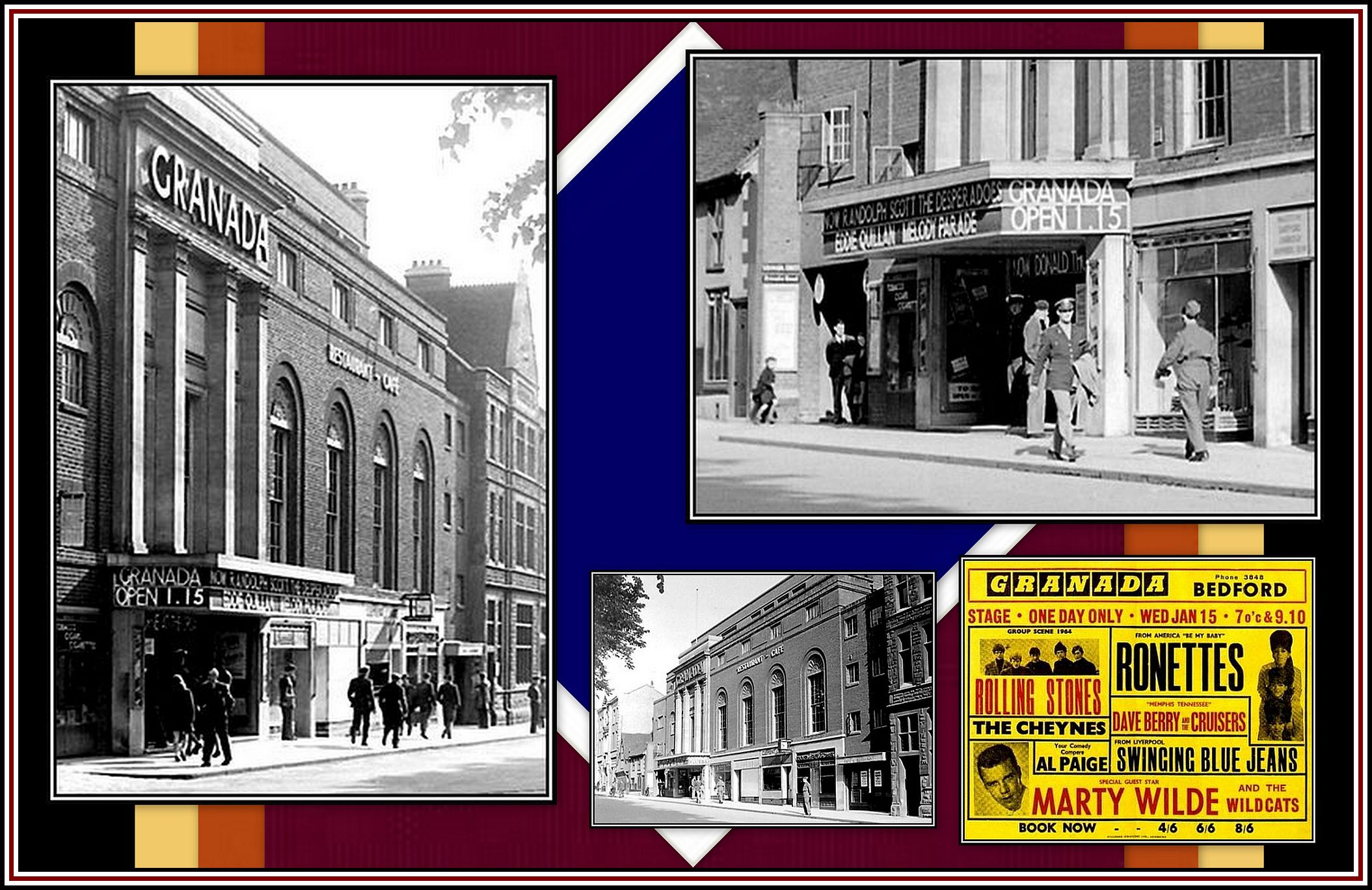 The Granada Theatre Bedford during the days of the Second World War
The Granada Theatre Bedford during the days of the Second World War
Top Right: Both American and British Servicemen are seen walking past the theatre, and if you look carefully, a Granada Sergeant is on duty and standing at the entrance.
Bottom Right: poster from a 1960s Stage Show
-oOo-
PART TEN: STARTING A CIRCUIT
THE GRANADA THEATRE CLAPHAM JUNCTION
—ooOoo—
The Granada Theatre Clapham Junction was advertised at the time of building as Your New Wonder Cinema and was the largest and grandest of theatres/cinemas in the Clapham area. It seated a questionable number, but was most likely 2,475, making it the third largest Granada Theatre built after those of Tooting and Walthamstow.
Unfortunately I never had the opportunity to visit the Granada Theatre Clapham Junction when it functioned as a theatre or Bingo Club. However judging by the photographs that I have seen of its exterior and the interior, it is clear that everyone involved with its building did an excellent job and produced one of the great theatres of its time. In addition, I have not yet had the joy of visiting the building now that it has been converted into apartments and a conference centre, but again, judging by the photographs I have seen, it has been converted and restored by a dedicated group of artisans who undertook their work with both dedication and the greatest of care.
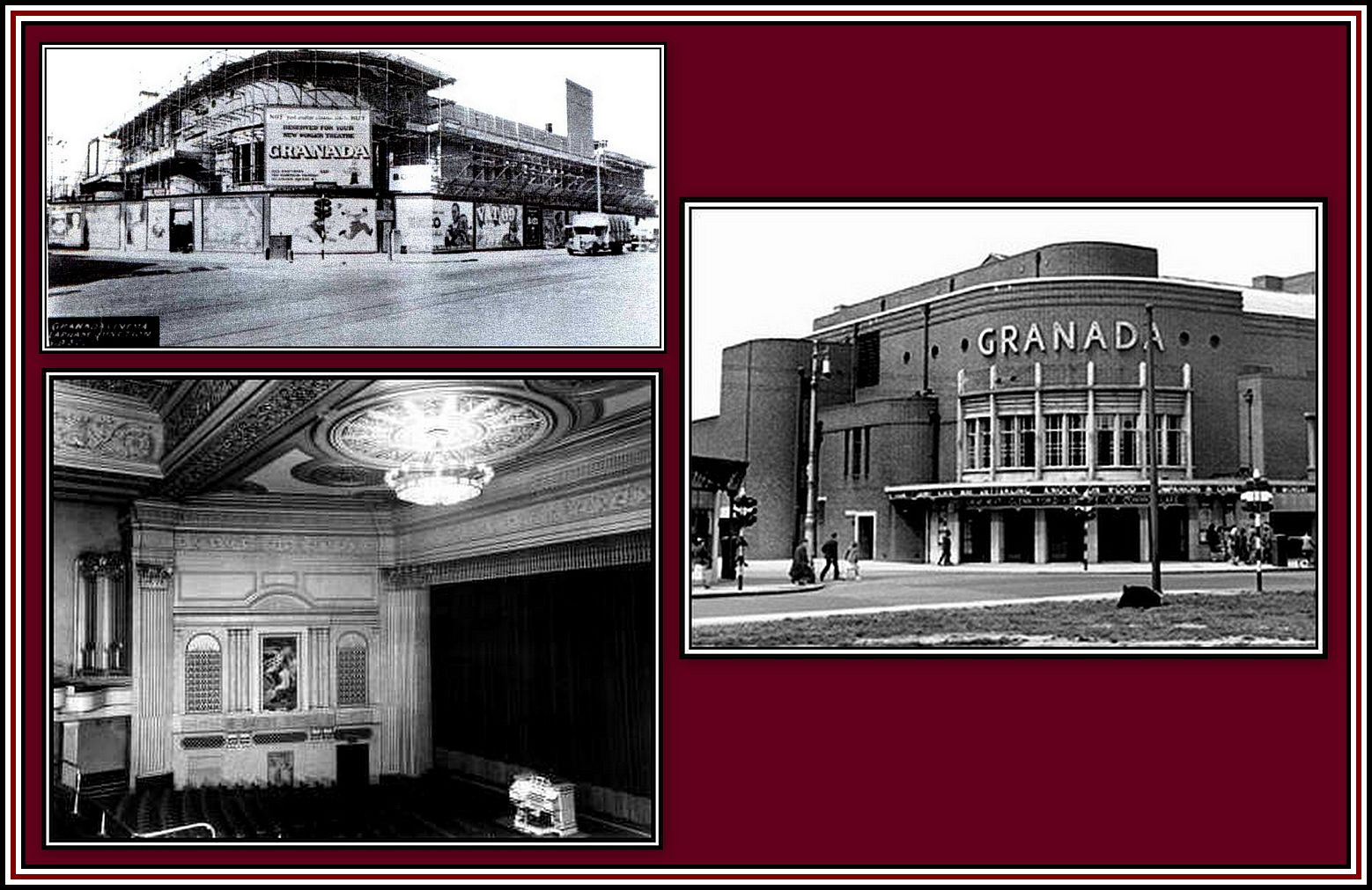 Granada Theatre Clapham Junction
Granada Theatre Clapham Junction
Top Left: while being built;
Bottom Left: the auditorium with the Wurlitzer Organ
This photograph appears with permission of Mr. Robert Plummer
Right: exterior view in the late 1960s
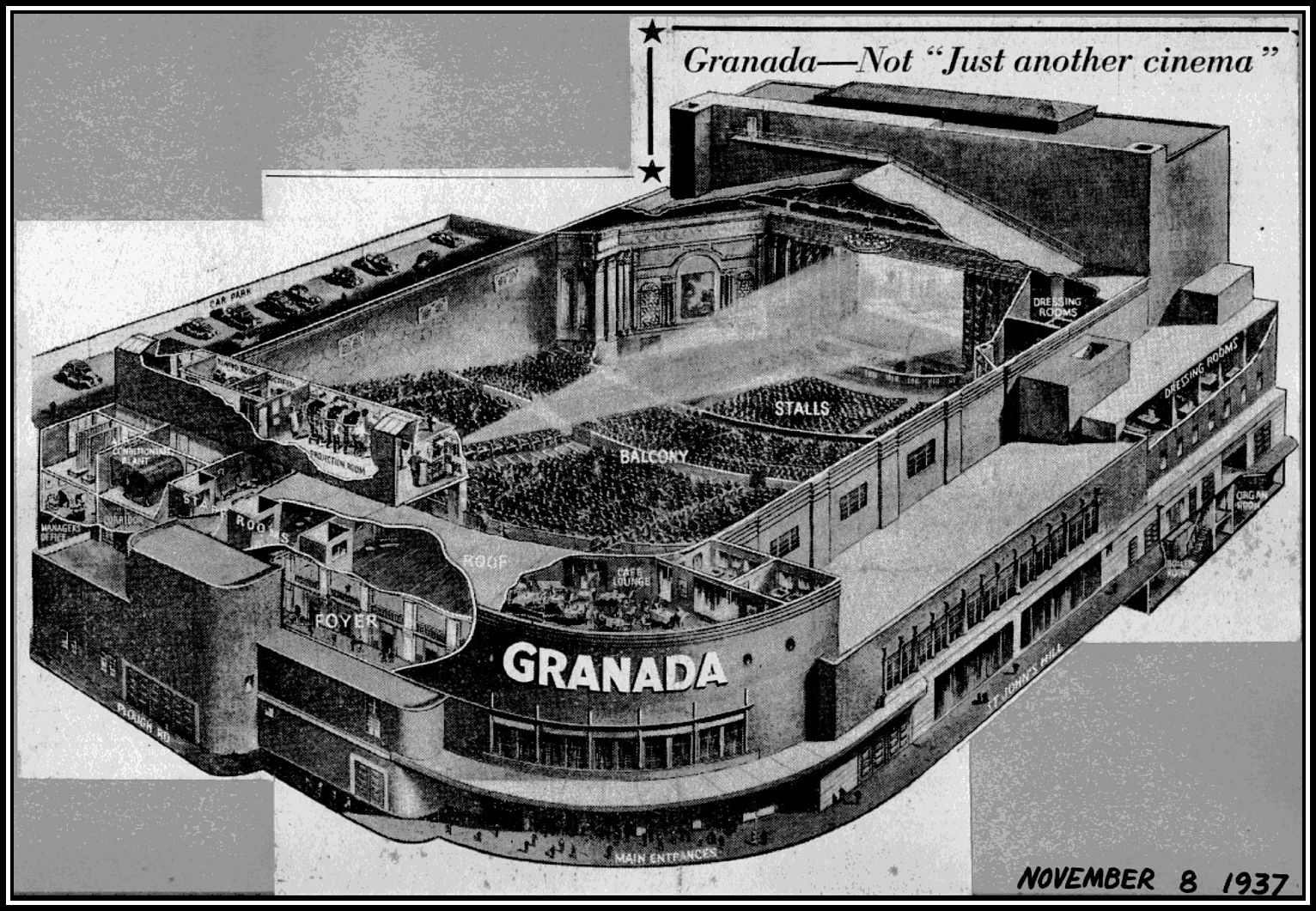
-oOo-
The Theatre opened in November 1937 with the Duchess of Kent present and with Victor McLaglen as the guest of honour. Apparently the crowds waiting outside the theatre, which included a thousand school children, and totaled over four thousand.
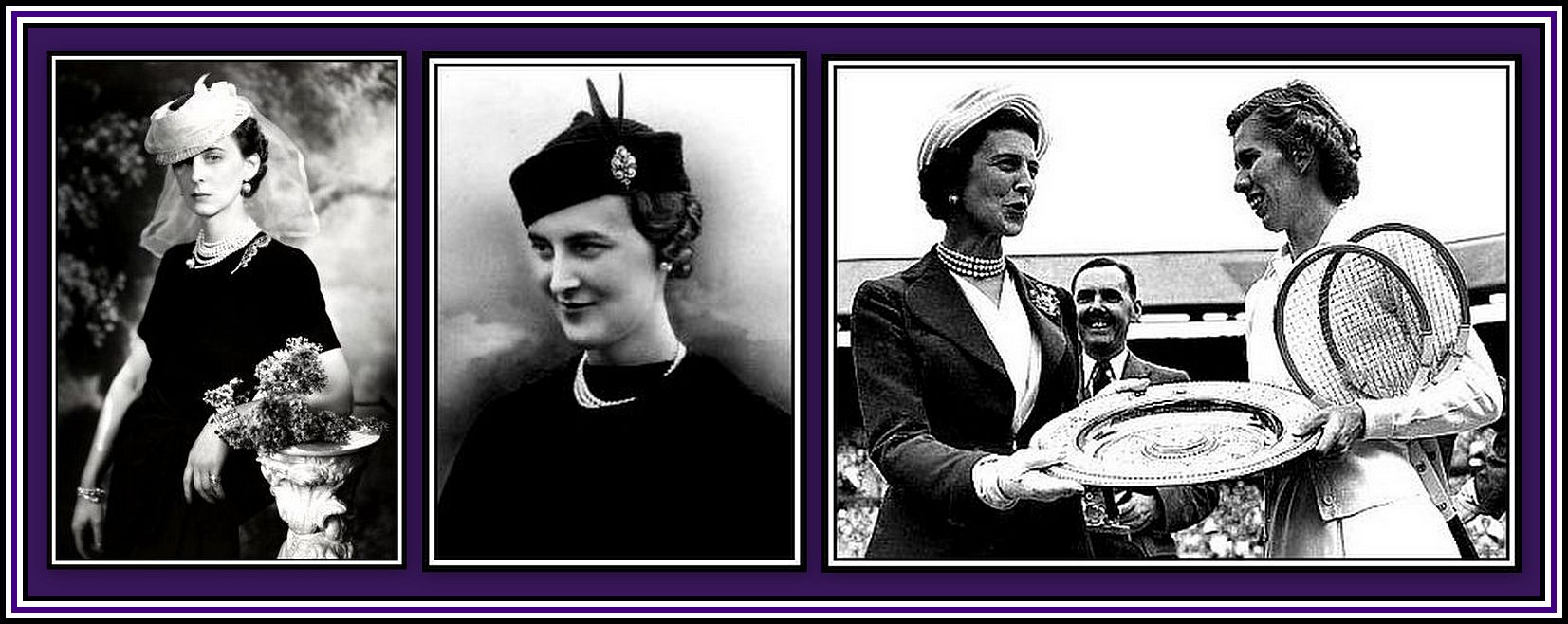 Princess Marina, Duchess of Kent (1906-1968) presenting Doris Hart (Right)
Princess Marina, Duchess of Kent (1906-1968) presenting Doris Hart (Right)
with the winner’s trophy at the The All England Croquet and Lawn Tennis Club in 1951
The crowd evidently swelled into the street causing the traffic to come to a halt making it necessary for the traffic lights to be switched off. To placate the crowd, the Trumpeters of the Scots Guards were brought out of the theatre to entertain them before returning to take part in the opening ceremony, which also included Bobby Howell & His Band and several pieces played on the Wurlitzer Organ by organist Donald Thorne.
-oOo-
The theatre opened with the screening of two films, History is Made at Night with Charles Boyer and Jean Arthur and Mr. Stringfellow says No with Neil Hamilton and Muriel Aked. Seemingly, there was no tableau vivant this time around.
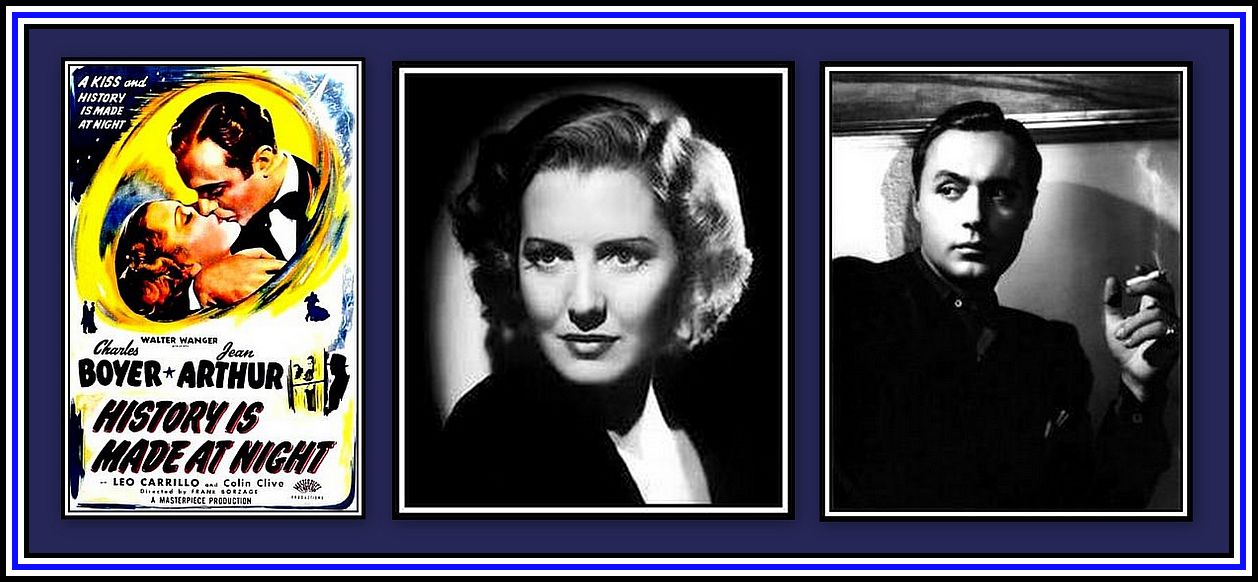 Left: Film Poster; Middle: Jean Arthur; Right: Charles Boyer
Left: Film Poster; Middle: Jean Arthur; Right: Charles Boyer
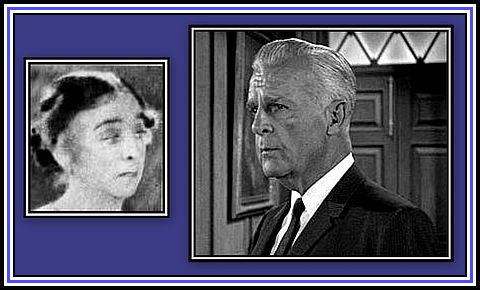 Left: Muriel Aked; Right: Neil Hamilton
Left: Muriel Aked; Right: Neil Hamilton
-oOo-
The Bernsteins chose Leslie C. Norton and H.B. Horner together with Cecil Audrey Massey as architects for this remarkable theatre. The theatre was built at the corner of a major and minor road. This allowing the entrance and canopy to be curved rather like that of the Phoenix Theatre on Charing Cross Road. The facade was in Art Deco style with a number elongated windows separating the canopy and the Granada name in huge letters above. Stretching around the major road (St. John’s Hill) was the cafe-cum-restaurant over the entrance and multiple dressing rooms and fly tower at the rear.
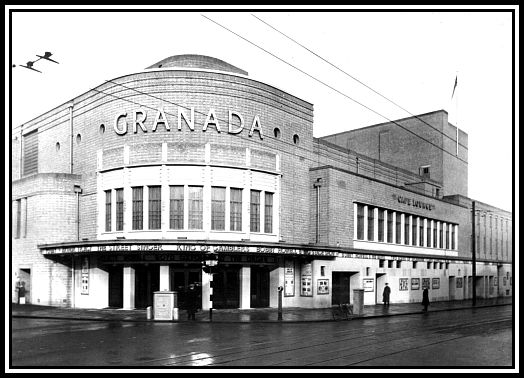 The Granada Theatre Clapham Junction during the early 1950s
The Granada Theatre Clapham Junction during the early 1950s
This photograph appears with permission of Mr. Clive Polden of the Cinema Theatre Association
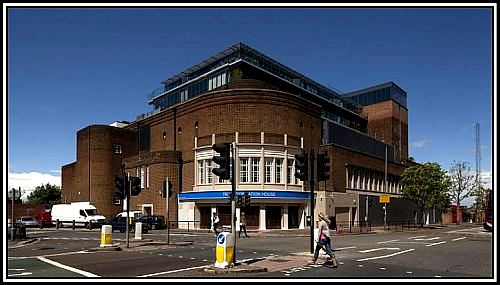 The Granada Theatre today as Transformation House and Lumiere Apartments
The Granada Theatre today as Transformation House and Lumiere Apartments
The interior was decorated in Italian Renaissance style by Theodore Komisarjesvky who gave it a more lavish look compared to the Standard Granadas being built at this time. However, although it has a lavish look, its lavishness is not as obvious as it was at the Granada Theatres Tooting and Woolwich. According to Allen Eyles in his book, The Granada Theatres, Mr. Komisarjevsky was ill at the time of building in Switzerland. Seemingly he was not allowed to talk at this time and when contacted for consultation, query resolution and instruction, he communicated via his doctor. Looking at the auditorium, this method of communication evidently did not hinder his contribution to the magnificence of the building.
-oOo-
Entrance to the theatre were through doors on the corner of the building. The entrance led into the outer foyer where an island box box was found.
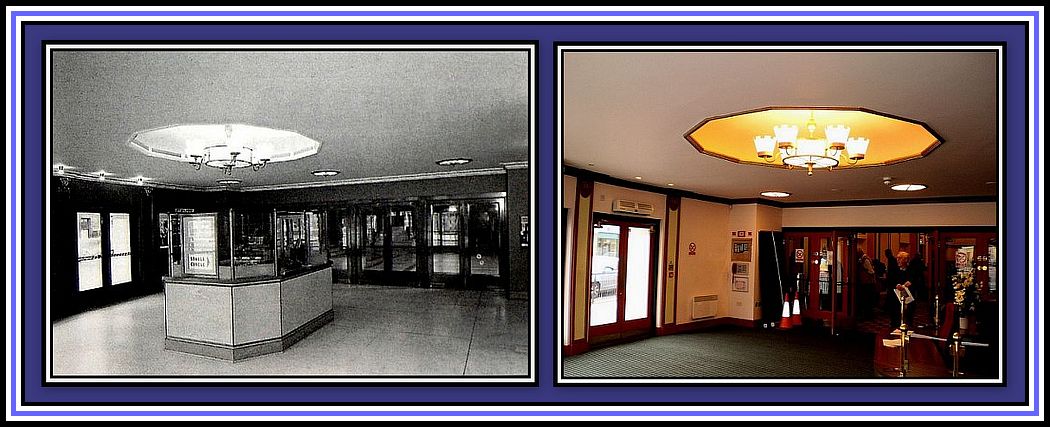 The Outer Foyer as it was & as it is today
The Outer Foyer as it was & as it is today
Left: as it was showing the island Pay Box;
Right: as it is today with an information desk having replaced the Pay Box
This photograph appears with permission of the photographer, towell_p
-oOo-
The outer doors led into an inner foyer that was extremely tastefully decorated with small delicate chandeliers and a staircase leading up to the promenade at the balcony level. In addition there were stairs leading up to the cafe and a cloakroom tucked away under the stairs to the balcony. The walls were covered with mirrors to help give the impression of space.
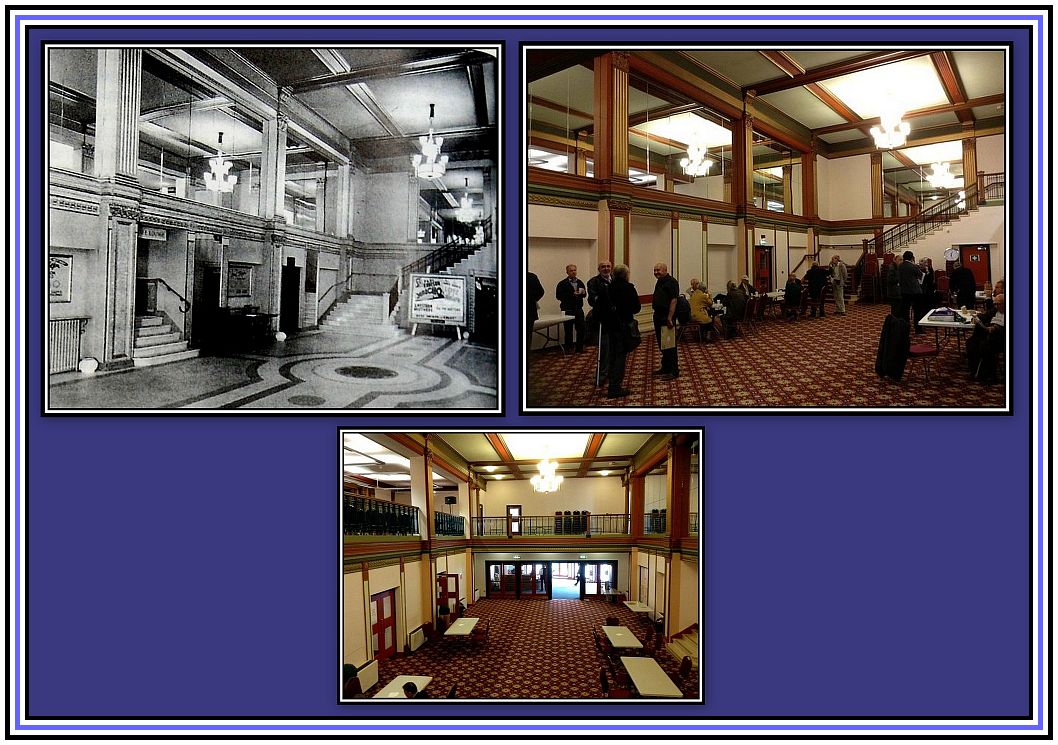 The Inner Foyer as it was & as it is today
The Inner Foyer as it was & as it is today
Top Left: the staircases, as they were: the one at the far end leading up to the circle and,
the one on the left, leading up to the lounge-cafe.
The cloakroom is seen between the two staircases.
Top Right: as it is today: the Inner Foyer is currently being used as a reception area;
note the stairs to the erstwhile circle are present
whilst those to the lounge-cafe have been closed off, as has the cloakroom.
Bottom: view of the Inner Foyer, as it is today looking towards the doors leading
to the Outer Foyer and showing the circle promenade above them.
These photographs appear with permission of the photographer, towell_p
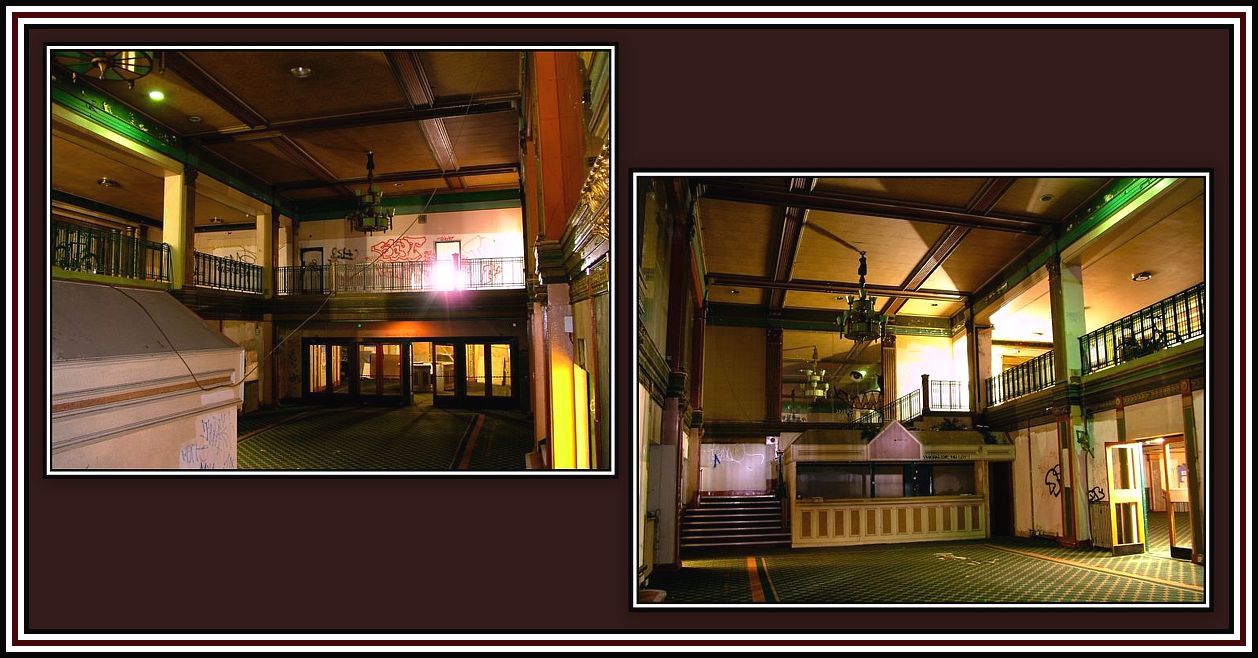 The Inner Foyer after the theatre’s Bingo Days came to an end
The Inner Foyer after the theatre’s Bingo Days came to an end
The chandeliers are in the colours of the Bingo Company; note the graffiti on the walls
Left: the Island Pay Box may be seen through the doors in the Outer Foyer
Right: the entrance to the stalls is seen on the right and a one-time information kiosk
is seen adjacent to the stairs to the balcony
These photographs are reproduced with permission of the photographer, Mr. Gary Painter
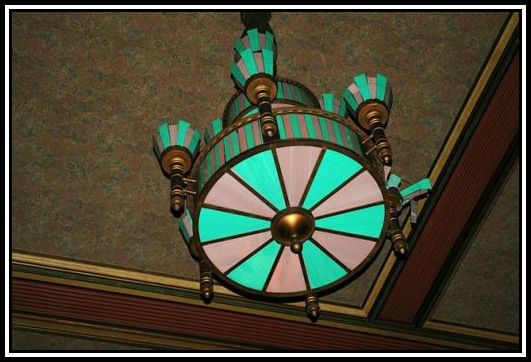 The Inner Foyer showing one of the Chandeliers in the colours of the Bingo Company
The Inner Foyer showing one of the Chandeliers in the colours of the Bingo Company
This photograph appears with permission of Mr. Robert Plummer
-oOo-
The ceiling of the auditorium over the circle was coiffed and highly decorative. There were four small chandeliers in the same design as those of the Inner Foyer hanging from this area of ceiling.
 The Ceiling of the Auditorium over the Circle as it was
The Ceiling of the Auditorium over the Circle as it was
Note the four chandeliers of similar design to those present present in the Outer Foyer
This photograph appears with permission of towell_p
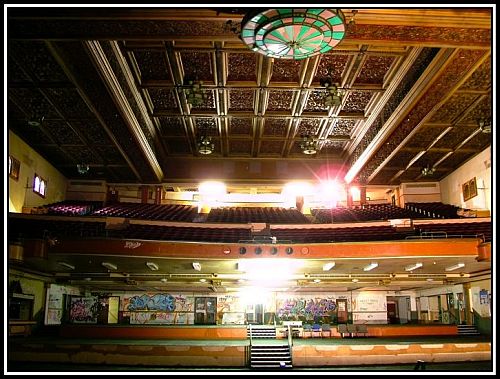 The Ceiling over the Circle following the theatre’s Bingo Days
The Ceiling over the Circle following the theatre’s Bingo Days
Note the graffiti on the rear walls of the stalls and the removal of the seating.
These photographs are reproduced with permission of the photographer, Mr. Gary Painter
There is a central chandelier over the front stalls, which is surrounded by a decorative Rondel, was decorated during the Theatre’s Bingo Days with the colours of the company.
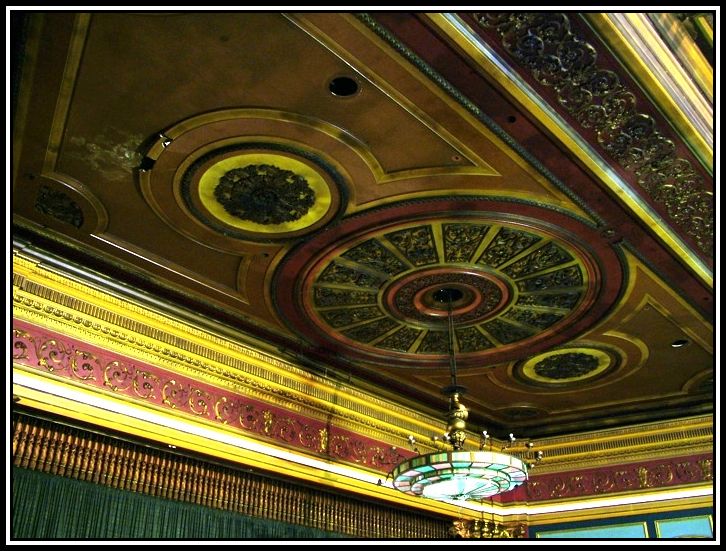
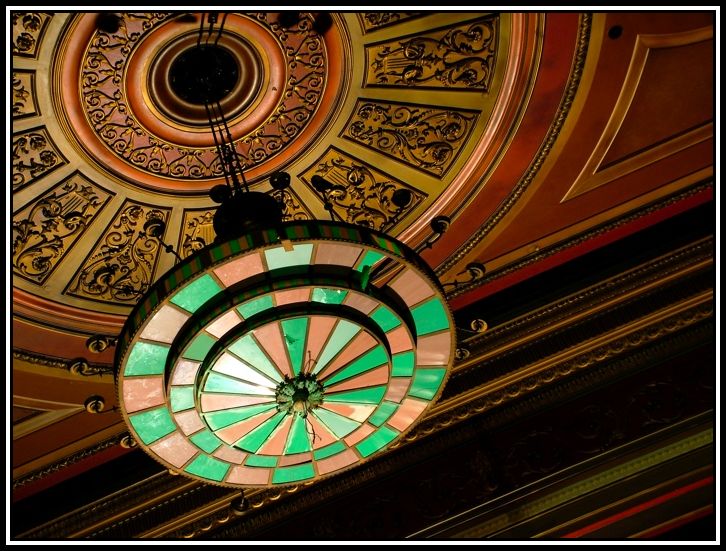 The Central Chandelier & Surrounding Rondel
The Central Chandelier & Surrounding Rondel
These photographs are reproduced with permission of the photographer, Mr. Gary Painter
-oOo-
Circle seating consisted of front and rear areas separated by a walkway. The rows are arranged in undulating rows, which is indicative of Cecil Audrey Massey’s impute. The circle walls are punctuated by a series of small roundheaded back lit faux windows arranged in pairs. Entrance to the circle is from the back of the auditorium with stairs leading down at the side walls and centre.
 Circle Seating, as it was
Circle Seating, as it was
This photograph is reproduced with permission of the photographer, Mr. Gary Painter
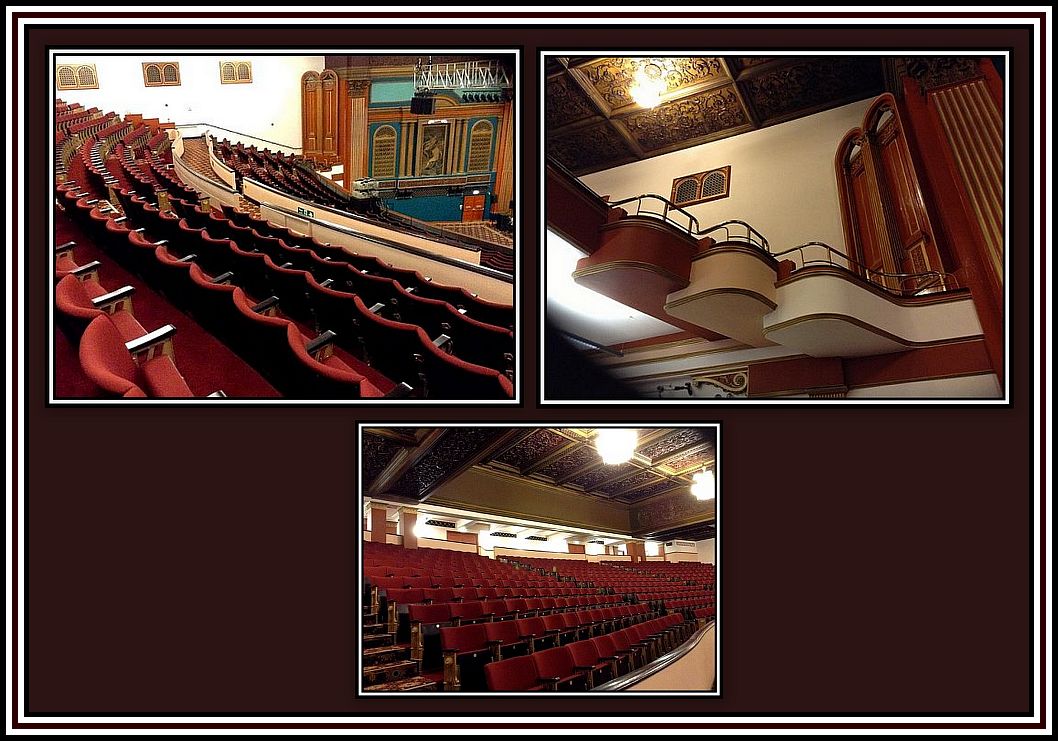 Circle Seating, as it is
Circle Seating, as it is
These photographs are reproduced with permission of the photographer, towell_p
-oOo-
The Proscenium Arch and side panels are simpler than those at the Granada Theatres at Tooting and Woolwich. However it is nonetheless impressive. The Proscenium is flanked each side by a stout fluted Corinthian pilaster decorated in gold and deep red, which are joined by a repeating series of what look like golden struts or pegs that stretches across the stage. There is no crown-like structure in front of the Proscenium, as there is at Tooting and Woolwich.
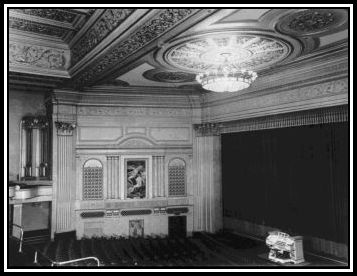 The Auditorium with the Wulitzer Organ at the time of Opening
The Auditorium with the Wulitzer Organ at the time of Opening
This photograph appears with permission of Mr. Robert Plummer
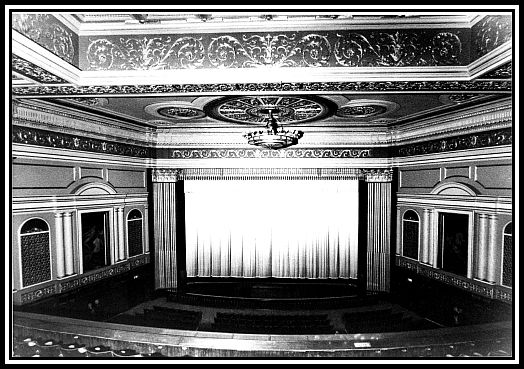 The Stage & The Proscenium, as they were
The Stage & The Proscenium, as they were
This photograph appears with permission of Mr. Clive Polden of the Cinema Theatre Association
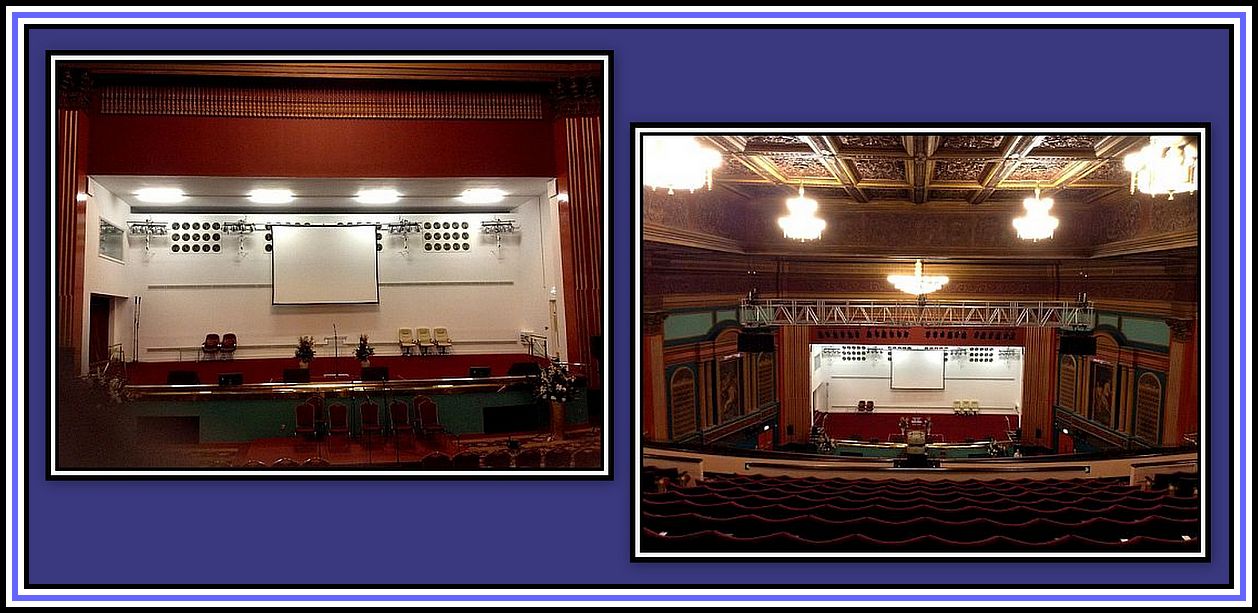 The Stage & The Proscenium, as it is (Left) from the stalls & (Right) from the circle
The Stage & The Proscenium, as it is (Left) from the stalls & (Right) from the circle
These photographs are reproduced with permission of the photographer, towell_p
-oOo-
On either side of the Proscenium are side panels (splays) that project back to the circle where they end at another stout fluted Corinthian pilaster. To my untrained eye, the decoration of the side panels seem almost ecclesiastical in appearance. Each panel consists of two grilles separated by a classical style painting with a frieze beneath consisting of a repetitive design. The same frieze is present above the panel at the Cornice and extends over the Proscenium. Unfortunately I can find no information about either the painter or what the paintings depict except that they each depict women in a semi-nude state and in repose. In the painting on the right, there is also a musical instrument.
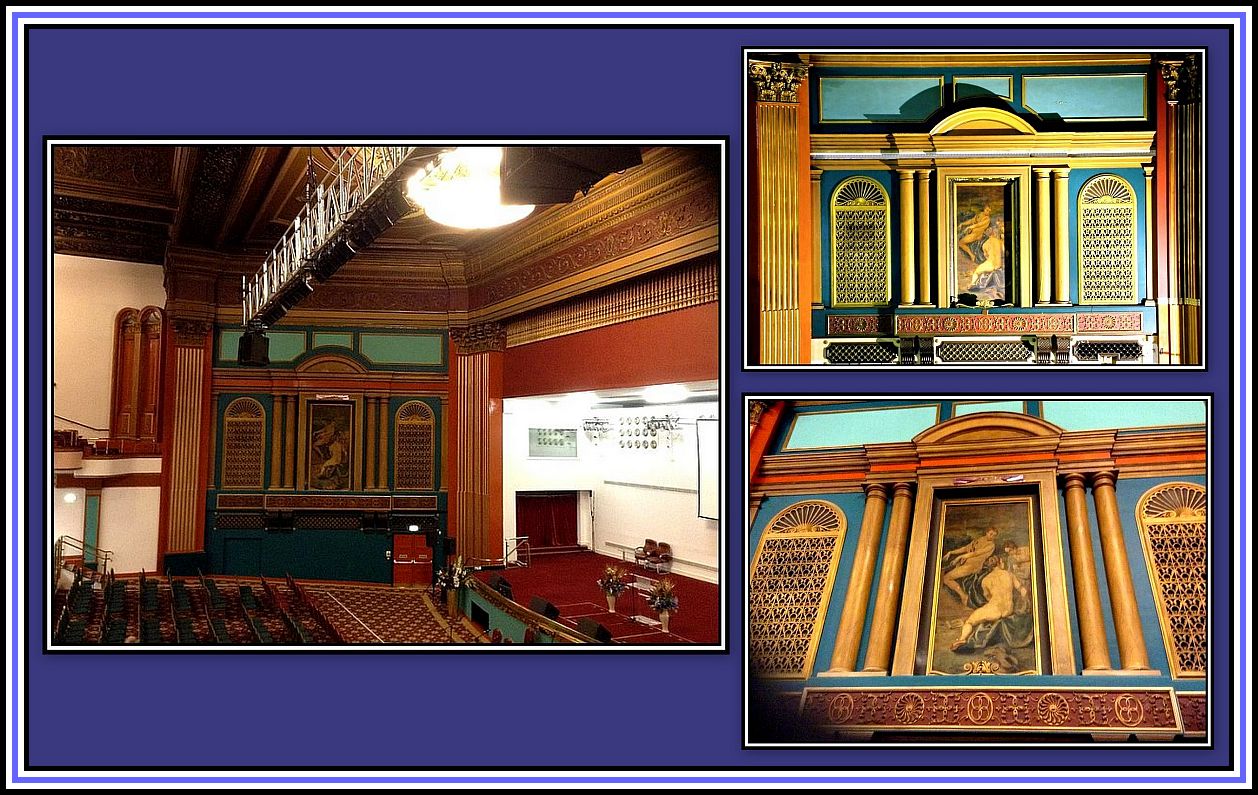 Left: The Left Splay, as it is today; reproduced with permission of Mr. Gary Painter
Left: The Left Splay, as it is today; reproduced with permission of Mr. Gary Painter
Top Right: The Left splay, as it is … in full
Bottom Right: The Left Splay in detail; reproduced with permission of towell_p
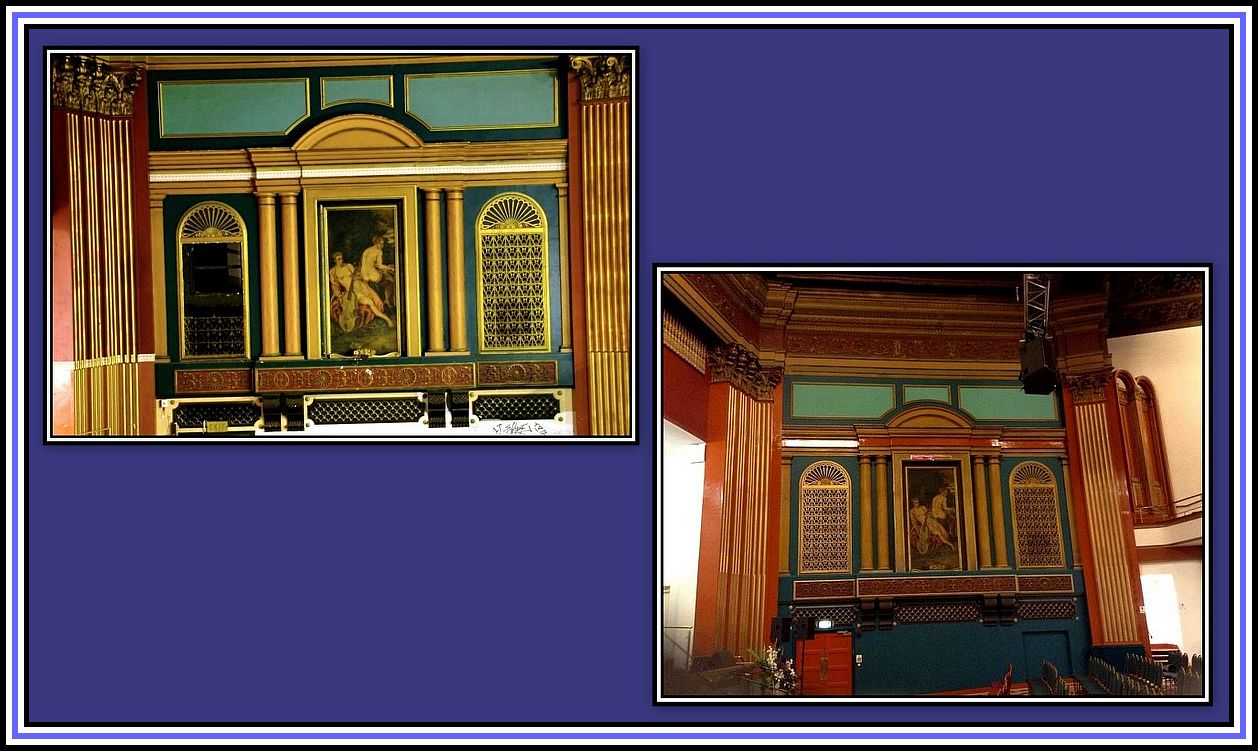 Left: The Right Splay, as it was: reproduced with permission of Mr. Gary Painter
Left: The Right Splay, as it was: reproduced with permission of Mr. Gary Painter
Right: The Right Splay, as it is today: reproduced with permission of towell_p
-oOo-
The Theatre was fitted with a Wurlitzer Organ and it was played a number of times for emission on BBC Radio. Reginald Dixon played it when he toured the Granada Theatres. At the time of the theatre’s closure, the organ had been sold and is now installed in a hall at the Collège Claparède in Geneva, Switzerland where it remains. Apparently the Organ is in working order and is played regularly and has a Society of Friends of the Organ who contribute to its upkeep.
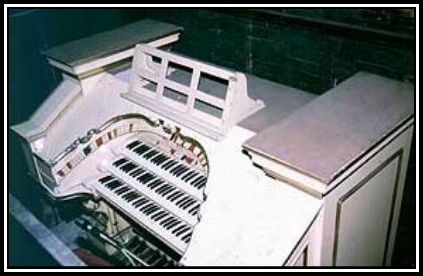 The Granada Theatre Clapham Junction’s Wurlitzer Organ
The Granada Theatre Clapham Junction’s Wurlitzer Organ
This photograph appears with permission of Mr. Robert Plummer
-oOo-
A COMMENT FROM ORGANIST, MR. SIMON GLEDHILL
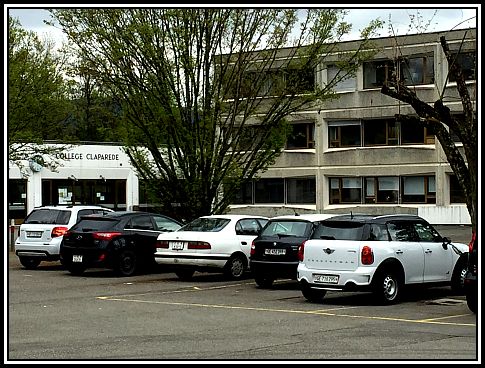 The Collège Claparède
The Collège Claparède
In April 2016, the organist Simon Gledhill, was invited to Geneva to play the erstwhile Wurlitzer Theatre Organ of the Granada Theatre Clapham Junction, now installed at the Collège Claparède in Geneva.
Mr. Gledhill was kind enough to offer the following reflections of the Theatre Organ:
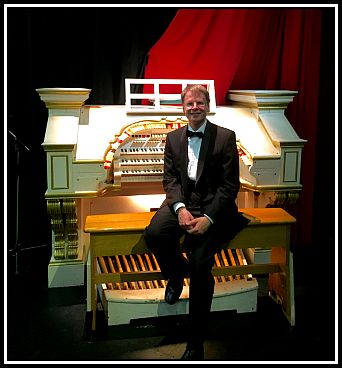
As you know, the Clapham Junction Wurlitzer was one of six essentially identical Granada 2 Wurlitzers. However, to my ears, it had a sound in the theatre which set it apart from the other five on recordings (I never heard it there live, unfortunately).
The under-stage installation at Clapham Junction was unusually effective, projecting the Organ sound into the auditorium clearly and at room-filling volume, with excellent bass development and a rich, if somewhat aggressive, ensemble. The English Horn was loud and bright, the Saxophone ditto, the Tuba had a slightly nasal quality, and the tremulated Tibia was also distinctive. Organists used to love to play there because they could hear the Organ clearly and in perfect balance from the console, and it was fast, responsive and jazzy.
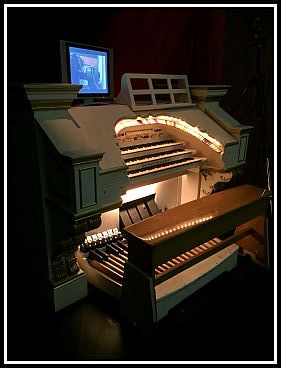 The Wurlitzer Theatre Organ at the Collège Claparède
The Wurlitzer Theatre Organ at the Collège Claparède
At Collège Claparède, even though the Organ now speaks into a very different (and smaller) room, it has retained many of these qualities, and I was delighted to find that the general effect was still instantly recognisable as that of the Clapham Junction Wurlitzer.
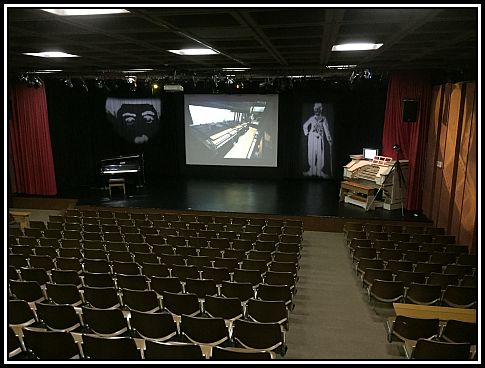 The Auditorium of the Collège Claparède
The Auditorium of the Collège Claparède
The Organ is maintained professionally and its condition is, overall, good. Some of the chests need leather repairs and this is in hand. The stop layout has been revised to accommodate stops-keys for two additional ranks – Clarinet and Vox Humana – which were prepared for on the console some time ago but have not been installed. The stop actions are now all-electric and the combination action (piston setter) is now electronic, with eight general pistons – no divisionals – and multiple memory levels. A Rönisch grand piano plays from the organ console. The effects department has been expanded by the addition of a Crockery Smash (a copy by Bernard Dargassies of the one in the ex-Gaumont-Palace, Paris Christie Organ, now at the Pavillon Baltard in Nogent-sur-Marne).
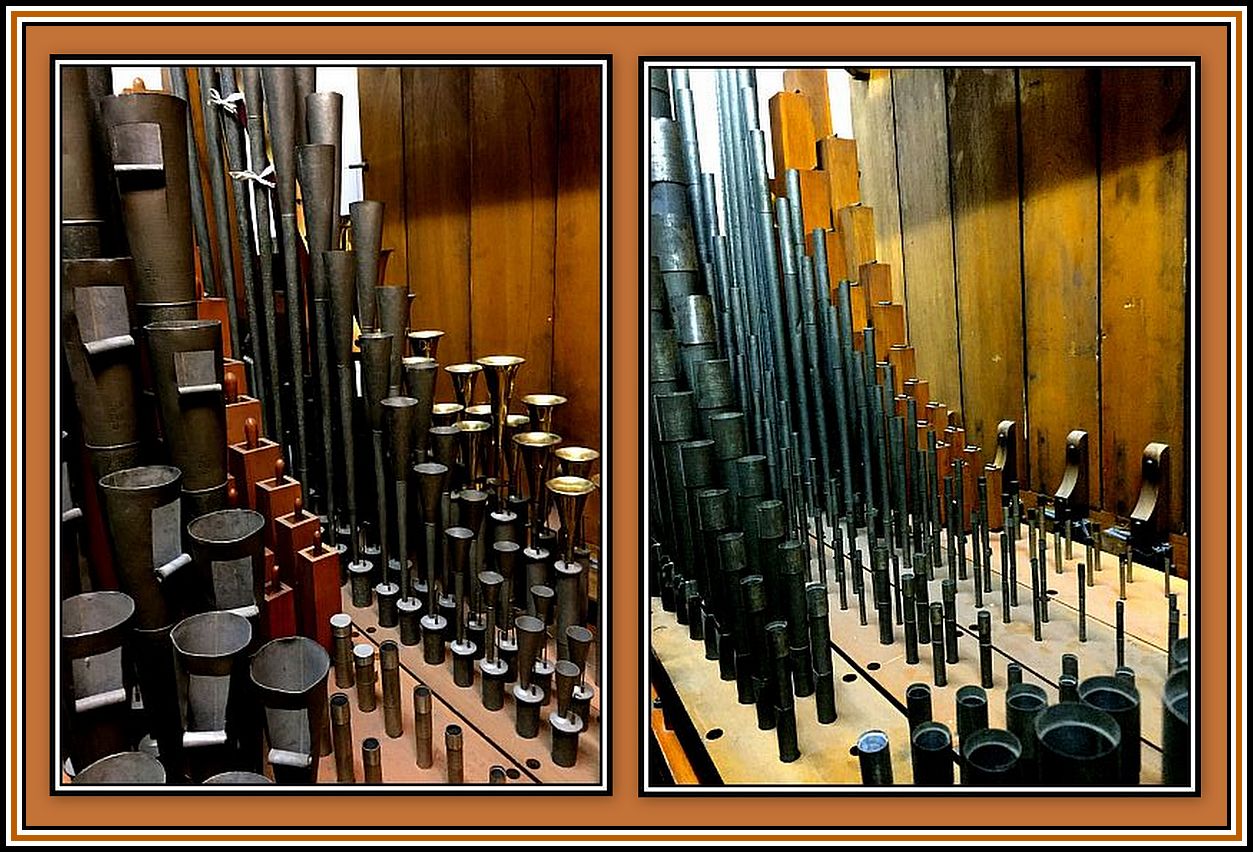 Some of the Ranks in the Main Chamber
Some of the Ranks in the Main Chamber
The Clapham Junction Wurlitzer is, in its current home, a most enjoyable organ to play, and the team now responsible for it – the Association of Friends of the Collège Claparède Cinema Organ (President: Nicolas Hafner) are to be congratulated on their energy, enthusiasm and custodianship of this fine and historic instrument.
Simon Gledhill
-oOo-
The Theatre seems to have been a success and offered two films together with a number of variety acts for a number of years. Evidently there was competition from the Grand Theatre, which was close by on St. John’s Hill, but was closer to Clapham Junction. The Grand also showed films together with numerous variety acts presented.
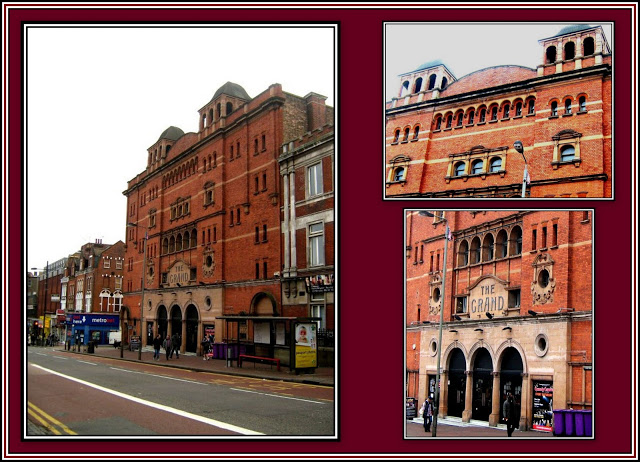 The Grand Theatre, St. John’s Hill, Clapham Junction
The Grand Theatre, St. John’s Hill, Clapham Junction
-oOo-
One of the highlights in the history of the Granada Theatre Clapham Junction took place on the evening of the 31st October, 1938 when the theatre hosted the Gala Charity European Premiere of the film, Letter of Introduction, in the presence of the Duchess of Kent.
The Gala was in aid of the Queen Elizabeth Children’s Hospital on Hackney Road, which I knew well as a child and is currently on the verge of demolition to make way for apartments despite great efforts to save it by many supporters. The Duchess of Kent had been a nurse, known as Sister Kay during the Second World War, and maintained her interest in nursing practice throughout her life.
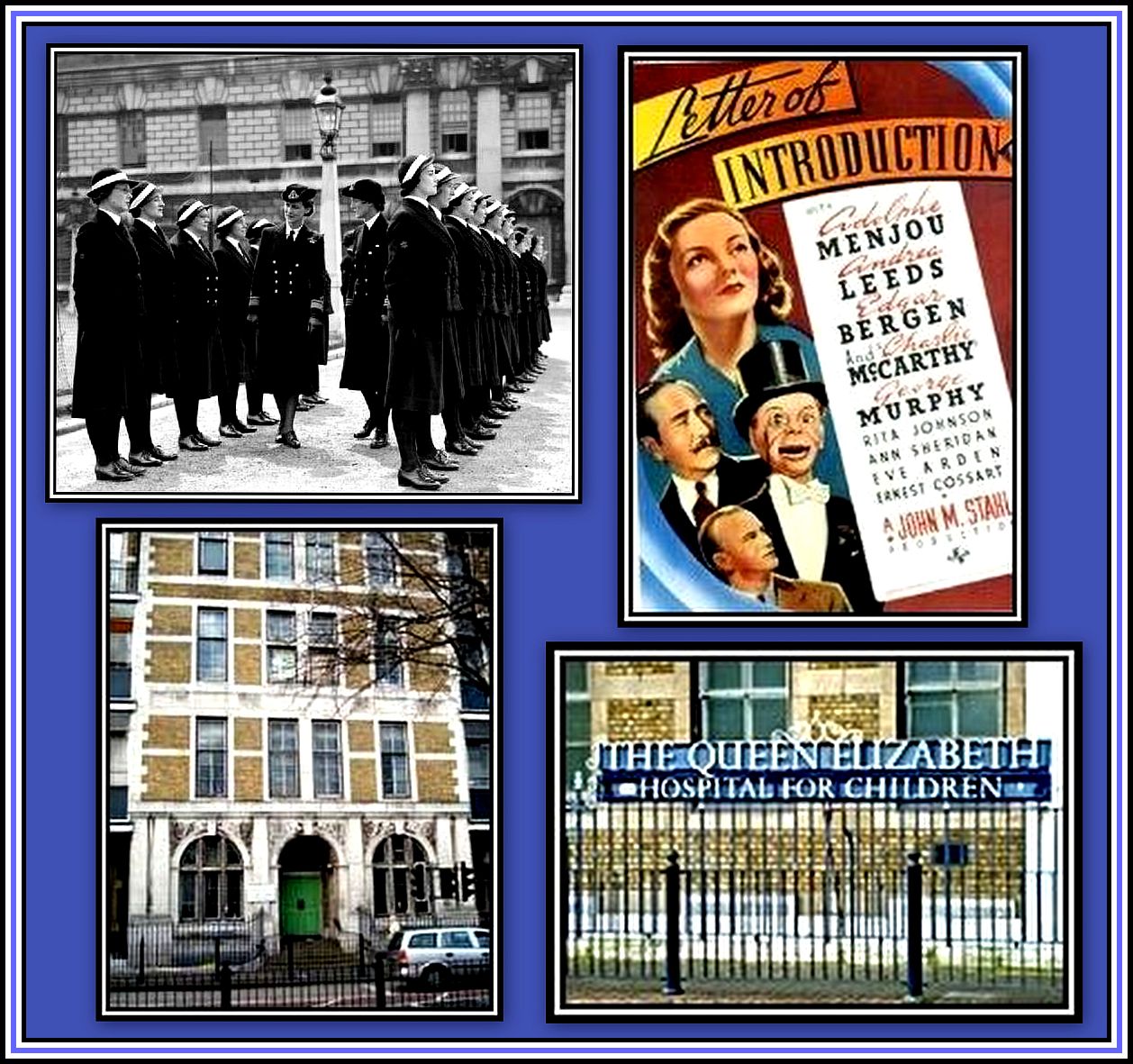 Top Left: The Duchess of Kent reviewing Wrens in 1940; Top Right: film poster
Top Left: The Duchess of Kent reviewing Wrens in 1940; Top Right: film poster
Bottom Left: main entrance of the Queen Elizabeth Hospital for Children, Hackney Road
-oOo-
Although the theatre was seemingly a success, the same can not perhaps be said of its cafe-cum-restaurant, as it closed permanently in 1940.
-oOo-
When I moved to Slough in 1956 and discovered first-hand several cinemas of the Granada Theatre Circuit, I remember noticing something of interest in the forecourt of the Granada Theatre on Windsor Road. This was its Pavement of the Stars, an attempt to mimic the hand- and footprints together with signatures of film stars in cement found in the forecourt of Grauman’s Chinese Theatre in Hollywood. (In January 2013, the theatre became known as the TCL Chinese Theatre since the naming rights had been sold to TCL Corporation).
Apparently during the early 1960s, the managers of the Granada Theatres at Tooting and Clapham Junction wanted to have their own Pavements of Fame. According to Allen Eyes in his book The Granada Theatres, the Granada Theatre Clapham Junction obtained the hand- and footprints of Bette Davis and Gary Merrill. However, these were never placed before the theatre and where these are now is unknown. Mr. Eyes also says that if any of these pavements, presumably from any of the Granada Theatres, is unknown. This is not entirely true, as I have tracked down some of those formally of the Granada Theatre Slough. This subject will be returned to later.
-oOo-
The Granada Theatre Clapham Junction, like all cinemas suffered from a decline in ticket sales as television gained more and more of a stronghold on the public. In an attempt to combat falling ticket sales by increasing the number of films on offer, the theatre was was tripled in 1973.
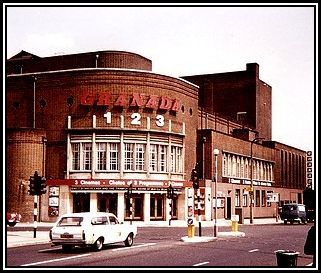 The Granada Theatre Clapham Junction following Tripling
The Granada Theatre Clapham Junction following Tripling
This photograph is reproduced with the permission of the photographer, dusashenka
Of the three screens on offer, the largest was the original circle. Two smaller screens were constructed in the rear stalls beneath the circle. Despite this effort, the theatre’s fortune did not fair better and all three screens closed on the 5th July, 1980. Sadly, the quality of the films being shown at that time were less than stellar with Zombies, Dawn of the Dead being the last feature to be shown in the main auditorium. Double features of further-less-than-sterling offerings were the last presentations shown in the smaller screens.
Following the closure of the theatre, it was returned to its original one auditorium and opened as a Granada Social Club soon afterwards.
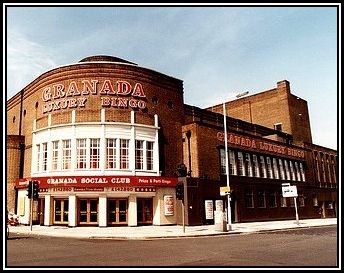 The Granada Theatre Clapham Junction as a Granada Social Club
The Granada Theatre Clapham Junction as a Granada Social Club
This photograph is reproduced with the permission of the photographer, dusashenka
This continued until May 1991 when the venue was taken over by Gala Bingo. Gala Bingo was formed at this time when Bass PLC purchased Granada Theatre Ltd’s Social (Bingo) Clubs.
Despite being under new management, the Gala Clapham Junction was closed on the 22nd December, 1997. The building remained empty without use for a number of years. During this time, it was broken into and was the site of illegal raves where some damage was done to the building. Later it was inhabited by squatters. Without doubt, a tragic time and fate for so illustrious and beautiful building.
In April 1998, English Heritage granted the building a Grade II listing, which was further upgraded to Grade II* in August 1999. Despite this honour, the building remained closed.
-oOo-
Various proposals were discussed as to what to do with the building. These including its re-opening as a theatre, a church, a bar and so forth. However none of the proposals were approved by the authorities. Finally the proposal that was accepted was one whereby the theatre (foyer and auditorium) would be converted into a church-cum-conference centre and where a number of apartments would be suspended above the theatre with additional apartments being built in the erstwhile fly tower.
The former foyer and auditorium underwent conversion to a church-cum-conference centre and opened in 2012, as Transformation House. The apartments suspended above are known as Lumiere House.
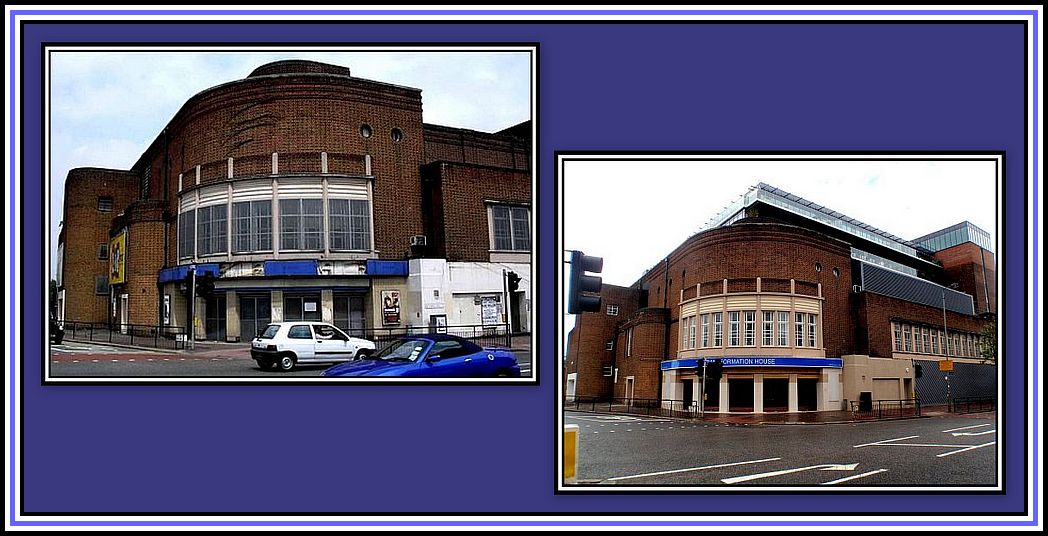 As it was (Left) ……. As it is (Right) …….. Transformation House & Lumiere House
As it was (Left) ……. As it is (Right) …….. Transformation House & Lumiere House
To my eye, the Centre together with the apartments make for an attractive combination and judging by the photographs on their websites, the apartments look great and the auditorium and foyer, now fully restored, look once again spectacular. Let us hope that this conversion-cum-restoration will inspire others to re-evaluate what can be done with other such wonderful buildings so that they may live on and not remain empty and decay to the point that they either fall down or else need to be demolished.
—oooOOOooo—
In November 2014, I was fortunate enough to be given a tour of Transformation House by Mr. Mark Featherstone. I was given free-range to photograph the building and those that I took may be seen by:
CLICKING HERE
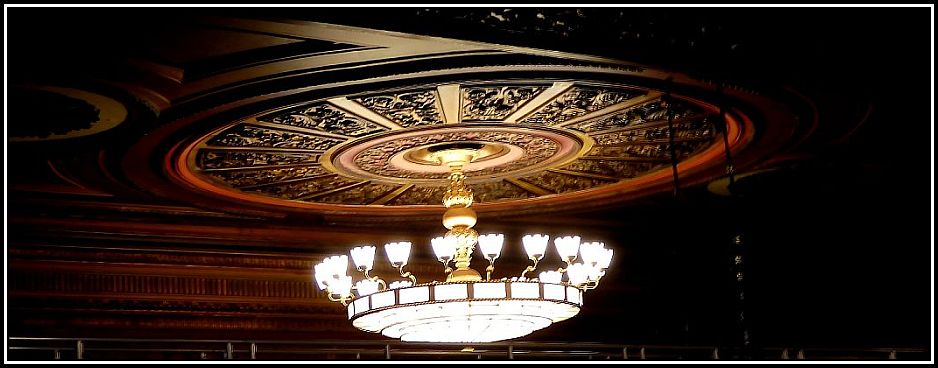 The Rondel and Central Chandelier of the Restored Auditorium
The Rondel and Central Chandelier of the Restored Auditorium
—oooOOOooo—
Recently I received an email from someone who passed by Transformation House on a visit to the old Battersea Town Hall on Lavender Hill. Here is what was contained in the message:
Battersea Town Hall had been ravaged by fire about a year ago and the authorities were now holding a small exhibition there to show the plans and architects’ models for the re-constructed Grand Hall. It seems that the project is well on-track. Walking past the former Granada Clapham Junction, I noticed that the shop units on the St John’s Hill frontage have now been let to an upmarket furniture retailer.
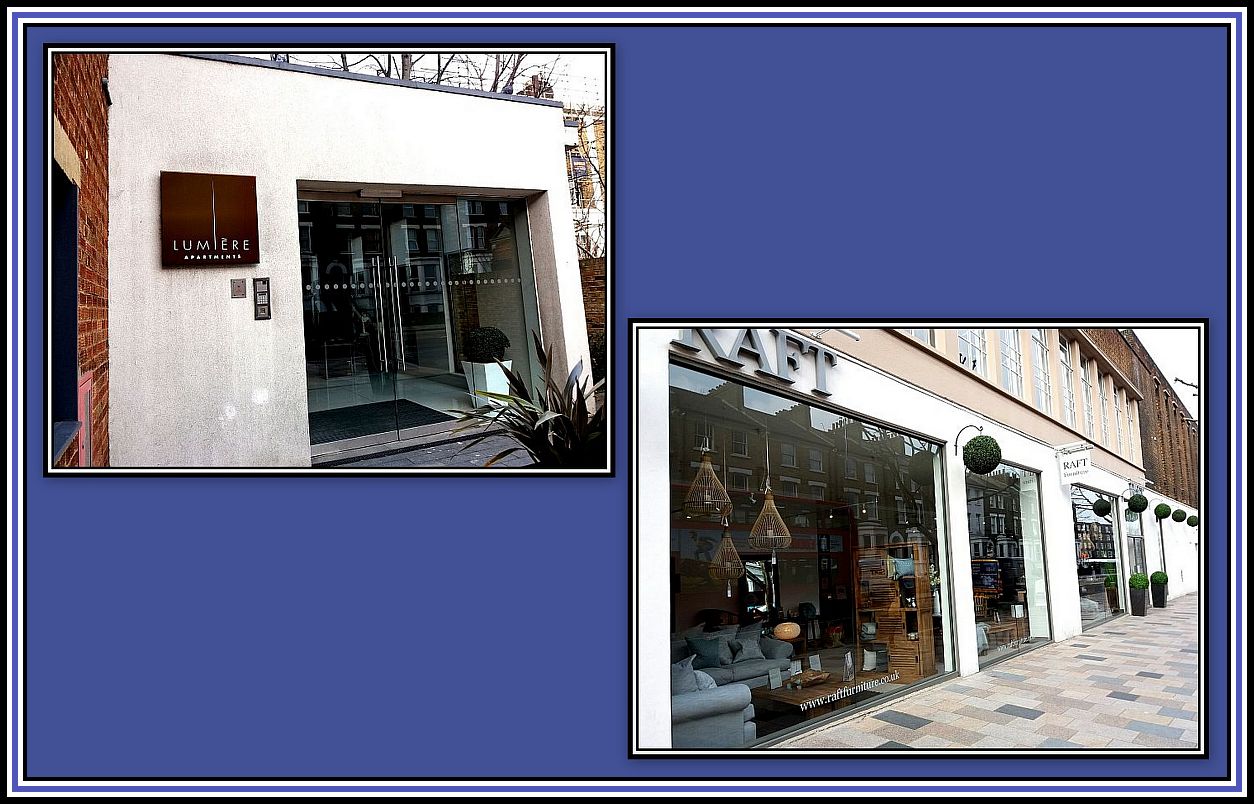 (Left) Entrance to Lumiere Apartments & (Right) Raft Furniture
(Left) Entrance to Lumiere Apartments & (Right) Raft Furniture
On my previous visit to the building to the Cinema Theatre Association-UK (cta-uk) annual meeting, these units were empty. Looking back to my childhood in Battersea, I can remember a single opening being made here for a Miss Candy sweetshop, which must have been during the mid 1950’s. Later, I seem to remember a Granada TV Rental shop opening here.
It’s really good to see such a wonderful 1930’s Theatre building being saved with its interior now expertly renovated back to – as far as possible – it’s original decor. I know its primary use is as a church, but I do hope that the local community use it for school prize days and amateur theatrical presentations. It’s a wonderful resource.
Peter Towell
——-oooOOOooo——-
ACKNOWLEDGEMENTS
I would like to thank Mr. Simon Gledhill for his comments and photographs of the erstwhile Wurlitzer Theatre Organ of the Granada Theatre Clapham Junction currently installed at the Collège Claparède, Geneva.
I wish to thank Mr. Peter Towell for allowing his comments and photographs to appear here and also Mr. Robert Plummer for allowing his photographs to also appear.
Finally, I would like to thank Mr. Mark Featherstone for taking me on a conducted tour of Transformation House and also to the staff of The House for allowing this tour.
—oooOOOooo—
CLICK HERE TO RETURN TO
PART 10: STARTING A CIRCUIT
—oooOOOooo—

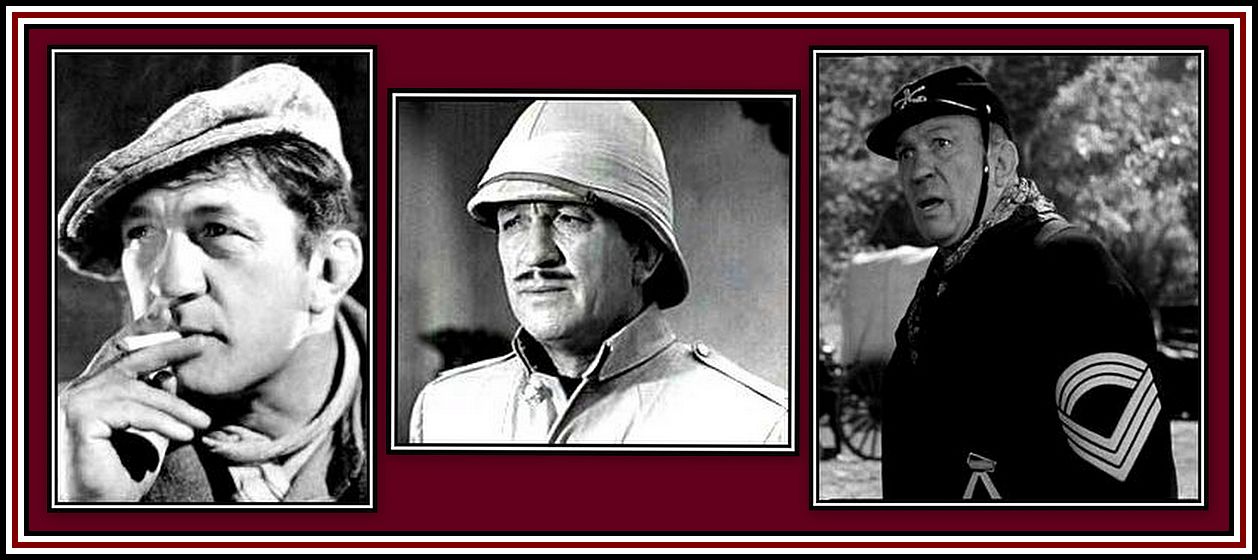
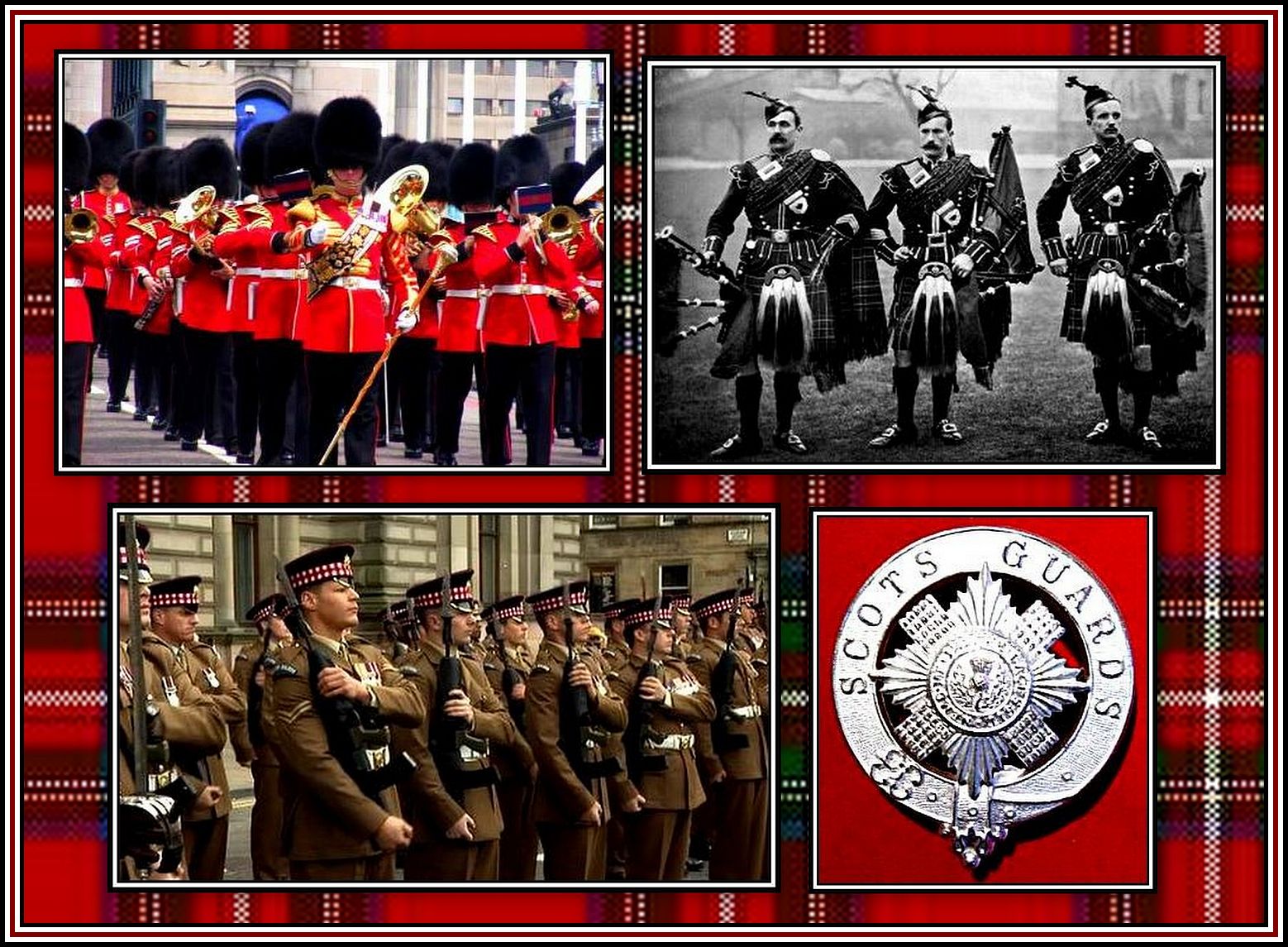
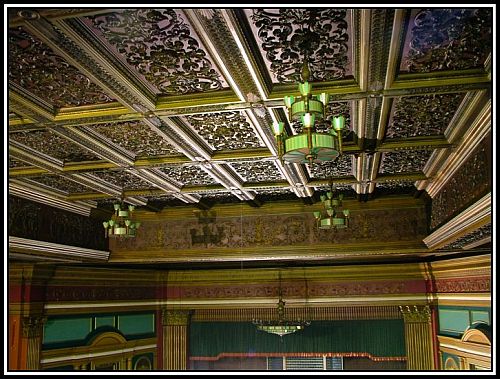
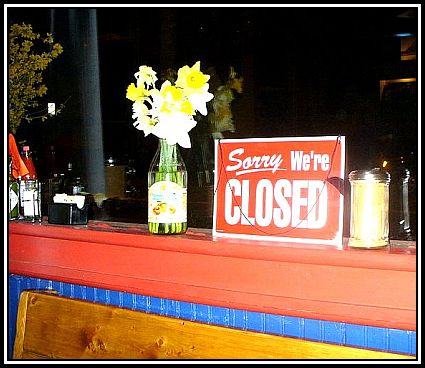
Another theatre I should have visited, with a Wurlitzer that obviously stood out from the other Granada specials. It is good the building survives, but a shame the organ had to emigrate. This is another deeply-researched piece with a wealth of contextual detail which shows, yet again, what a significant contribution the Super-Cinemas made to the lives of the communities in which they stood. The set of pictures on flickr added further breadth; it always amazes me how far the care and detail extended into the buildings themselves. I know how long you spent in compiling the piece and I’m sure I will not be the only reader grateful that you did.
Would you be able to help with a very, very vague memory I have?
In the mid to late 1950’s when I was 6-8 years old we lived on the Ashburton Estate, Putney Heath. One day, we were told that if we went over to the green opposite The Green Man pub (top of Putney Hill and at the edge of Putney Heath), we could see Roy Rogers and Trigger!!
When we got there, there they were, Trigger in the corral for horses ( I think the corral, or pound was for riders using Wimbledon Common and Putney Heath to leave their horses when they visited the pub) and Roy sitting on the fence.
Even though I was so young, it has always stuck in my memory. Was I imagining it?
The only bit of evidence I can find is a vague reference to Roy Rogers and Trigger appearing at The Granada Theatre, Clapham Junction at about that time. Can you confirm this? Maybe they were on some sort of promotional tour?
Many thanks
Mr. Archer: Thank you for your fascinating email. I have looked into whether Roy Rogers et al ever appeared at the Granada Theatre Clapham and have sent you an email of my findings. As far as I am concerned, I would like to think that they did and that your memory is based in reality. Thanks for sharing your wonderful memory. Regards.